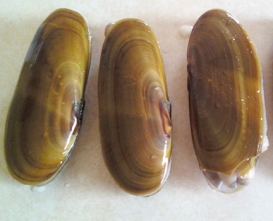
CDFW photo
Northern California clammers take note! The California Department of Fish and Wildlife (CDFW) has closed the recreational razor clam fishery in Del Norte County as of November 9, 2023 to protect public health. The season was closed after state health agencies found that consuming recreationally harvested razor clams from the area poses a significant health risk due to domoic acid exposure.
Domoic acid is a neurotoxin produced by Pseudo-nitzschia, a naturally occurring, single-celled marine algae. In early November, razor clams from Crescent Beach in Del Norte County exceeded the current federal action level for domoic acid of greater than or equal to 20 parts per million.
Domoic acid poisoning in humans may occur within minutes to hours after eating affected seafood and can result in symptoms ranging from vomiting and diarrhea to permanent loss of short-term memory (Amnesic Shellfish Poisoning), coma, or death. There is no way to prepare clams that will remove the toxin – cooking and freezing have no effect.
While the recreational fishery in adjacent Humboldt County is open as of November 9, 2023, razor clam sampling is ongoing. If domoic acid levels in Humboldt County exceed federal action levels, the fishery there will be closed as well. Please check for current advisories before going clamming.

CDFW photo
CDFW will continue to work with the California Department of Public Health and Office of Environmental Health Hazard Assessment to collect, monitor and analyze razor clams to determine when the recreational clam fishery in Del Norte County can reopen safely.
Bivalve shellfish like clams and mussels can accumulate domoic acid in their tissues without being harmed. Razor clams are known to accumulate domoic acid, which may not clear their system until long after a Pseudo-nitzschia bloom has abated.
Not every Pseudo-nitzschia bloom produces domoic acid. Predicting harmful blooms is currently not possible, because the ocean conditions that favor domoic acid production are not known.
More Information
- Read the CDFW press release, Fish and Wildlife Director Closes Razor Clam Fishery in Del Norte County
- Read the California Department of Public Health press release, Consumers Warned Not to Eat Sport-Harvested Razor Clams from Del Norte County
- For information on any fishery closure or health advisory, please visit CDFW’s Shellfish and Finfish Health Advisories web page.
- To get the latest information on current fishing season closures related to domoic acid, please call CDFW’s Domoic Acid Fishery Closure Information Line at (831) 649-2883.
- For the latest consumption warnings, please visit the California Department of Public Health’s Marine Biotoxin Quarantines and Health Advisories web page.
- Read the CDFW Director’s Declaration of Public Health Fisheries Closure Caused by Elevated Levels of Domoic Acid in Razor Clams
- Read the Recommendation to Close the Recreational Razor Clam Fishery in Del Norte County – from the California Office of Environmental Health Hazard Assessment
- Review recreational clamming regulations.
post by Mary Patyten, CDFW Research Writer

